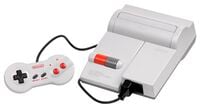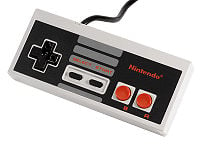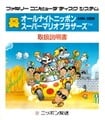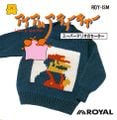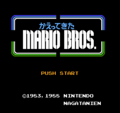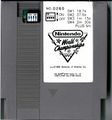Nintendo Entertainment System
- Not to be confused with Ness.
Template:Articleabout Template:LLQuote
The Nintendo Entertainment System (known as the NES for short) is a video game console created by Nintendo. It is the western version of the Famicom and has controllers that can be removed (unlike the Famicom). Games are inserted by opening a door and sliding the game in, then pushing a panel down. The NES was made because it was thought that the original system looked too much like a toy and therefore was made with a more complex appearance. Template:Refneeded
It was the system that revived the video game industry after the Video Game Crash of 1983. It rivaled against the Sega Master System and the Atari 7800 until the release of the Super Nintendo Entertainment System ushered in the next generation of video game consoles. The NES sold over 60.91 million units worldwide during its lifetime and was discontinued in 1995.[1]
The Nintendo Entertainment System was bundled with Super Mario Bros., resulting in it being the console's most successful game. For decades, Super Mario Bros. was the highest-selling video game ever, with 40.23 million copies sold, until Nintendo packaged Wii Sports with the Wii. Eventually, Super Mario Bros. 3 was released in the USA, and it became an instant hit, making five hundred million dollars in less than twenty-four hours. It soon became the second most purchased game in the gaming world with over 18 million copies sold.
Due to the lack of security, many NES games have become pirated, creating games such as 999-in-1, but due to better security, these games have seemingly slowed down.
In America, the NES was sold in three packages:
- Control Deck: Contained the console, two controllers and the needed connections.
- Action Set: This set included the console, two controllers, the Super Mario Bros./Duck Hunt cartridge, the Zapper, and the connections.
- Power Set: The most complete package, it contained the console, two controllers, a Super Mario Bros./Duck Hunt/World Class Track Meet cartridge, the Zapper, the Power Pad, and the connections.
Hardware
The NES/Famicom hardware consists of 2 kilobytes of onboard RAM, a custom second source MOS Technology 6502 based processor (called the Ricoh 2A03 in NTSC regions and the 2A07 in the PAL regions) which has a built in sound generator on chip and is used as the main processor. The Ricoh 2A03/2A07 contains 5 channels of sound: 1 triangle channel, 2 square wave channels, 1 noise channel and 1 DPCM channel for playing samples from memory. The Ricoh 2A03/2A07 is essentially the same as a regular 6502 but with the binary code decimal mode removed.
The video generator hardware is the Picture Processing Unit (PPU) (Ricoh 2C02 "NTSC"/Ricoh 2C07 "PAL") which is responsible for generating the sprites and background images onscreen. Graphical capabilities,extended RAM and even sound capabilities can be expanded with the use of memory mappers like the MMC2, 3, 4, 5 and Konami VRC6 among other mappers. For instance the MMC5 adds 2 extra pulse wave channels and another Raw PCM channel in addition to the main 2A03/2A07 channels; the Konami VRC6 adds a sawtooth wave channel and 2 extra square waves and the VRC7 adds FM Synthesis capabilities which is based on the Yamaha YM2413 OPLL FM Synthesizer and is a derivative of the OPLL chip.
The only 2 Mario games that use memory mappers are Super Mario Bros. 2 and Super Mario Bros. 3 with the MMC3 mapper being used. The only Mario cameo appearance that uses memory mappers is Mike Tyson's Punch Out with the MMC2 being used which is also the only NES game that uses that particular mapper.
Accessories
It has been requested that this section be rewritten and expanded to include more information.
NES Controller
The NES Controller is the basic controller that comes with the console. It has the and
buttons along with the
and
buttons. It also includes a
. The scheme of the NES controller is the base for all of the newer controllers: the
on the left, buttons on the right, and the
and
buttons in the middle. There are two versions of the NES Controller: the orginal "brick" design and the "dog bone" controller. The original controller has a brick design whereas the later controller which is included with the NES-101 Top Loader model has a dog bone design similar to the SNES controller.
Power Glove
The Power Glove is a glove like accessory for the NES. It uses hand movements to communicate with NES games.
Game Gallery
Please note that this gallery also includes Japan-only Famicom and Famicom Disk System games.
- Donkey Kong NES Cover.PNG
- Donkey Kong Jr. NES Cover.PNG
- DK3 Cover.jpg
- Ss dkjr+sl.gif
- Dk1.jpg
- F1Race.PNG
- HotRally.PNG
- Golf Boxart.PNG
- Mario Bros. NES Cover.PNG
- NESgolf-cover.jpg
- Pibolim.PNG
- SMB Boxart.PNG
- SMB TLL Boxart.PNG
- SMB2 Boxart.PNG
- SMB3 Boxart.PNG
- Wrckcover.jpg
- Famicom disk system-doki doki panic.jpg
Appearances in the Mario series
- At the beginning of the Super Mario Bros. Super Show episode "Mama Mia Mario", as Mario and Luigi are relaxing in front of the TV, Luigi is seen holding an NES controller.
- At the beginning of Super Mario Bros.: Peach-hime Kyushutsu Dai Sakusen!, Mario can be seen holding a Famicom controller.
- In Super Paper Mario, one of Francis' protected rooms has a NES, along with various other Nintendo consoles.
- The NES appears as one of Wario's treasures in Wario World.
- 9-Volt has an NES in WarioWare: Twisted!.
Name in other languages
Trivia
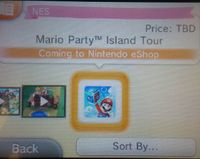
- An NES controller appears as one of the tokens in the 2006 and 2007 version of Nintendo Monopoly.
- This console is in the 1st spot of IGN's Top 25 Game Consoles.
- A large NES controller appears in Wreck-It Ralph as a door leading to the coding of the game Sugar Rush, which the character King Candy opens by putting in the Konami code (up, up, down, down, left, right, left, right, B, A, start), a very famous button input that was put in as a cheat in numerous Konami games, first appearing in Gradius (1986).
- An expansion port is located underneath the console. However, no accessories were used for it. Although the Famicom Disk System was planned for a North American release and if released it would have used the Expansion Port. However, the redesigned NES-101 Top Loader model lacks the expansion port entirely.
- For a time the Nintendo 3DS eShop mistakenly stated Mario Party: Island Tour to be a title on the NES.
- The NES port of Wario's Woods is the only NES game with an ESRB rating, due to it being released so late in the console's run.
